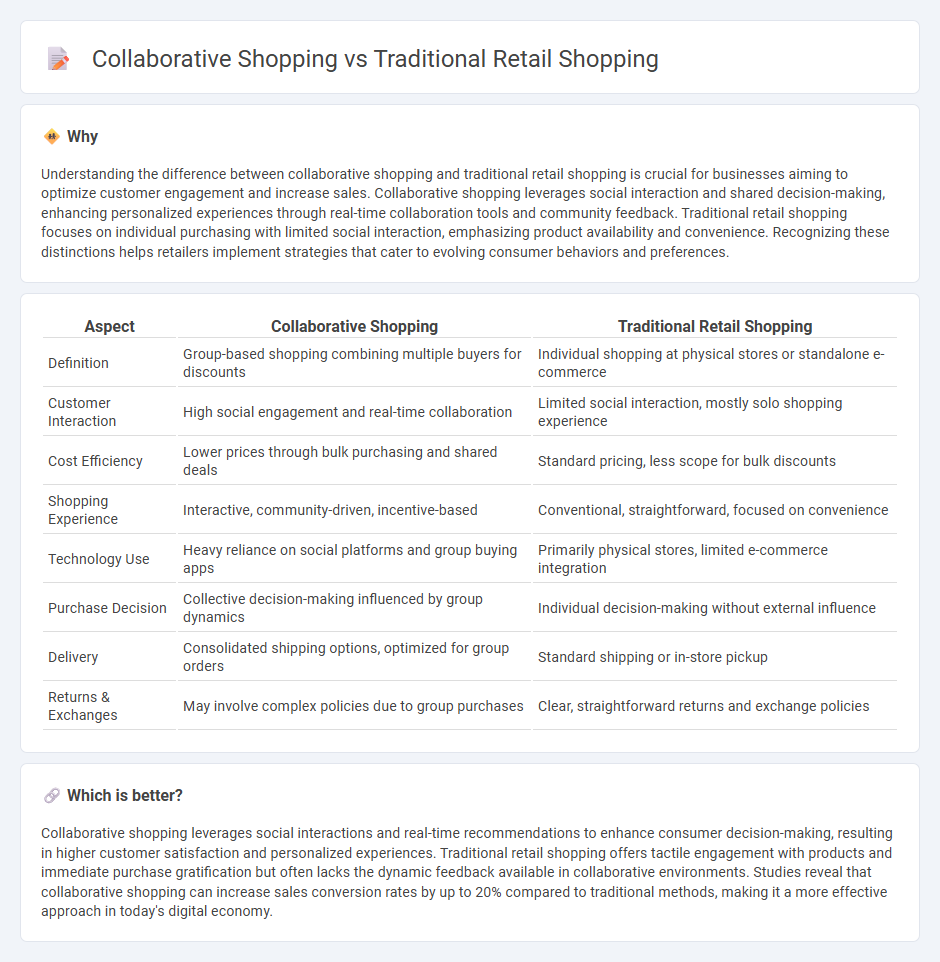
Collaborative shopping leverages social interaction and shared decision-making, enhancing customer engagement compared to traditional retail shopping, which relies on individual browsing and direct transactions. This modern approach integrates digital platforms and community feedback to create personalized shopping experiences, increasing customer satisfaction and loyalty. Explore how collaborative shopping is transforming consumer behavior and retail strategies today.
Why it is important
Understanding the difference between collaborative shopping and traditional retail shopping is crucial for businesses aiming to optimize customer engagement and increase sales. Collaborative shopping leverages social interaction and shared decision-making, enhancing personalized experiences through real-time collaboration tools and community feedback. Traditional retail shopping focuses on individual purchasing with limited social interaction, emphasizing product availability and convenience. Recognizing these distinctions helps retailers implement strategies that cater to evolving consumer behaviors and preferences.
Comparison Table
| Aspect | Collaborative Shopping | Traditional Retail Shopping |
|---|---|---|
| Definition | Group-based shopping combining multiple buyers for discounts | Individual shopping at physical stores or standalone e-commerce |
| Customer Interaction | High social engagement and real-time collaboration | Limited social interaction, mostly solo shopping experience |
| Cost Efficiency | Lower prices through bulk purchasing and shared deals | Standard pricing, less scope for bulk discounts |
| Shopping Experience | Interactive, community-driven, incentive-based | Conventional, straightforward, focused on convenience |
| Technology Use | Heavy reliance on social platforms and group buying apps | Primarily physical stores, limited e-commerce integration |
| Purchase Decision | Collective decision-making influenced by group dynamics | Individual decision-making without external influence |
| Delivery | Consolidated shipping options, optimized for group orders | Standard shipping or in-store pickup |
| Returns & Exchanges | May involve complex policies due to group purchases | Clear, straightforward returns and exchange policies |
Which is better?
Collaborative shopping leverages social interactions and real-time recommendations to enhance consumer decision-making, resulting in higher customer satisfaction and personalized experiences. Traditional retail shopping offers tactile engagement with products and immediate purchase gratification but often lacks the dynamic feedback available in collaborative environments. Studies reveal that collaborative shopping can increase sales conversion rates by up to 20% compared to traditional methods, making it a more effective approach in today's digital economy.
Connection
Collaborative shopping enhances traditional retail shopping by integrating social interaction and real-time customer feedback within physical store environments, creating a seamless omnichannel experience. Retailers leveraging collaborative platforms enable shoppers to share product insights, coordinate purchases, and access personalized recommendations, which boost in-store engagement and sales. This synergy drives increased customer loyalty and adapts traditional retail to digital consumer behaviors.
Key Terms
Brick-and-mortar
Brick-and-mortar retail shopping offers direct product interaction and immediate purchase gratification, while collaborative shopping enhances the in-store experience through social engagement and co-browsing technology. Collaborative shopping in physical stores leverages advanced AI tools and mobile apps to facilitate real-time communication, personalized recommendations, and shared decision-making among shoppers. Explore how integrating collaborative shopping transforms traditional retail environments and boosts customer satisfaction.
Peer-to-peer
Traditional retail shopping centers on individual purchases from established brands and stores, emphasizing convenience and product variety. Collaborative shopping, particularly peer-to-peer (P2P) models, leverages social networks and shared resources to enhance customer engagement, reduce costs, and promote sustainable consumption. Explore how P2P platforms are reshaping the consumer experience and driving the future of retail.
Sharing economy
Traditional retail shopping relies on individual purchasing experiences within physical stores or online marketplaces, emphasizing personal ownership and direct transactions. Collaborative shopping, driven by the sharing economy, promotes resource sharing, communal consumption, and access-based models, enhancing social interaction and sustainability through platforms like peer-to-peer rentals and group buys. Explore how the sharing economy reshapes consumer behavior and retail dynamics for a future of connected commerce.
Source and External Links
Grab and Go Autonomous Stores vs. Traditional Retail - AiFi - Traditional retail offers a tangible, immediate shopping experience with personalized customer service and in-person engagement that many consumers still prefer, despite challenges such as long lines and limited hours.
The Fall of Traditional Retail Commerce | Nexcess - Traditional retail evolved from mom-and-pop shops to department stores and shopping malls, becoming not just shopping venues but social centers before the rise of e-commerce shifted consumer habits.
E-commerce vs Traditional Retail: The pros and cons - Traditional retail excels in providing immediate product access, tactile experience, and personal interaction, which contribute to customer loyalty, while e-commerce offers cost efficiency and 24/7 accessibility.
 dowidth.com
dowidth.com